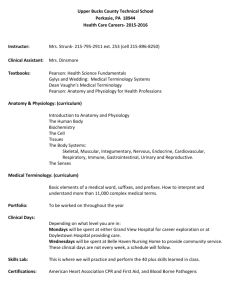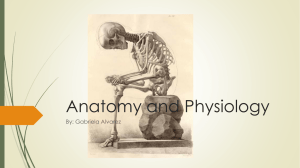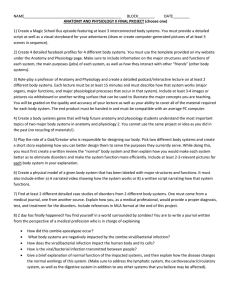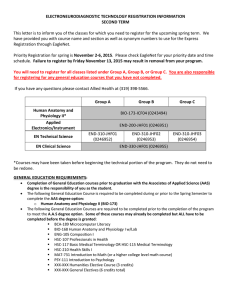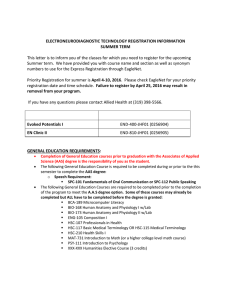HCCS A P ll 2402-010COURSE 45255CURRICULUM FALL 2013.doc
advertisement
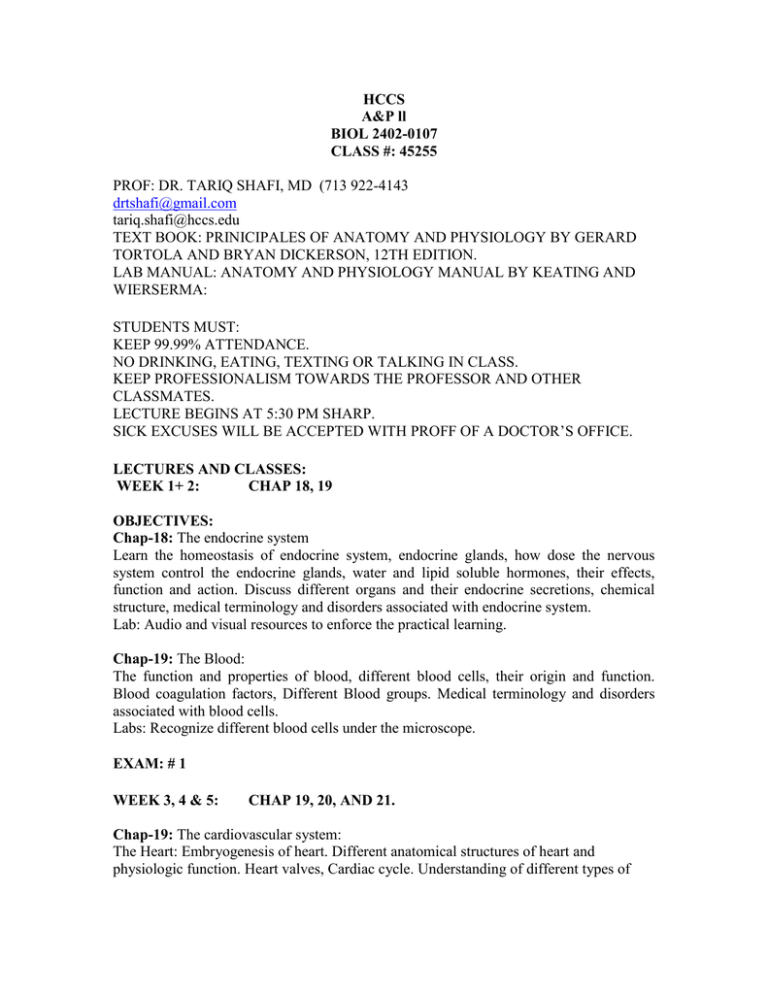
HCCS A&P ll BIOL 2402-0107 CLASS #: 45255 PROF: DR. TARIQ SHAFI, MD (713 922-4143 drtshafi@gmail.com tariq.shafi@hccs.edu TEXT BOOK: PRINICIPALES OF ANATOMY AND PHYSIOLOGY BY GERARD TORTOLA AND BRYAN DICKERSON, 12TH EDITION. LAB MANUAL: ANATOMY AND PHYSIOLOGY MANUAL BY KEATING AND WIERSERMA: STUDENTS MUST: KEEP 99.99% ATTENDANCE. NO DRINKING, EATING, TEXTING OR TALKING IN CLASS. KEEP PROFESSIONALISM TOWARDS THE PROFESSOR AND OTHER CLASSMATES. LECTURE BEGINS AT 5:30 PM SHARP. SICK EXCUSES WILL BE ACCEPTED WITH PROFF OF A DOCTOR’S OFFICE. LECTURES AND CLASSES: WEEK 1+ 2: CHAP 18, 19 OBJECTIVES: Chap-18: The endocrine system Learn the homeostasis of endocrine system, endocrine glands, how dose the nervous system control the endocrine glands, water and lipid soluble hormones, their effects, function and action. Discuss different organs and their endocrine secretions, chemical structure, medical terminology and disorders associated with endocrine system. Lab: Audio and visual resources to enforce the practical learning. Chap-19: The Blood: The function and properties of blood, different blood cells, their origin and function. Blood coagulation factors, Different Blood groups. Medical terminology and disorders associated with blood cells. Labs: Recognize different blood cells under the microscope. EXAM: # 1 WEEK 3, 4 & 5: CHAP 19, 20, AND 21. Chap-19: The cardiovascular system: The Heart: Embryogenesis of heart. Different anatomical structures of heart and physiologic function. Heart valves, Cardiac cycle. Understanding of different types of heart murmurs. Coronary circulation. Pace maker of the heart. EKG understanding. Medical terminology and various disorders of the heart. LAB: How to take EKG, understanding of EKG basic readings, listen to different heart sounds and how to distinguish normal heart sound from abnormal heart sound. Chap-20: Continue cardiovascular hemodynamic, and vascular system (Arterial and Venous system). Medical terminology, and disorders associated with arterial and venous system LAB: Audio visual resources to emphasize learning. Chap-21-22 (combination): Lymphatic System and immunity. Lymphatic system structure and function. Lymphatic organs and function. T and B cells production, function and immunity. Innate immunity VS Adaptive immunity VS cell mediated immunity etc. MHC classification, and function. Classification of immunoglobulin and function and their role in body immunity. Complement system activation and results of activation. -----------------------------------------------------------------------------------------------------------WEEK 6: Finish chap 22 and review previous chapters for reinforcement of the previously learned chapters. LAB: Terminology and disorders associated with lymphatic system, Lymphomas, and autoimmune disorders. EAXM: # 2 -----------------------------------------------------------------------------------------------------------WEEK 7: CHAP 23: The Respiratory System. The respiratory system anatomy, embryology, mechanism of respiratory muscles, central and peripheral control of respiration.. Spirogram and lung volumes. Effects of high altitude on breathing. Perfusion and diffusion mechanics of respiratory system. Transport of hemoglobin and CO2 across the lung membranes. -----------------------------------------------------------------------------------------------------------WEEK 8, 9: CHAP 23, 24: Finish Chap 23 , use visual videos and graphics in Lab to reinforce the learning. Listen to breathing sounds on each anatomical lobes of the lungs., medial terminology and ailments of the respiratory system. Start chap 24: The digestive system. Digestive system anatomy, embryology. Gastric secretions an physiology. Liver anatomy and physiology, bilirubin production, conjugated VS un-conjugated bilirubin. SPRING BREAK!!!!! WEEK 10: Continue Chap 24, Pancreas and gallbladder. Pancreatic hormones and diabetes, fasting VS well fed state and pancreatic hormones. Gall stones. Anatomy and physiology of small and large intestines, food absorption an digestion. LAB: Identify different gastric structures, use of visual material and videos to reinforce the learning. Medical terminology and disorders associated with digestive system. Start Chap: 25 The metabolism and Nutrition. Metabolic reactions, biochemical reactions and products of lipids, proteins, carbohydrates. Kreb cycle, ATP production, NAD, NADPH, FAD, FADH comparison and function Nutrition, different minerals and vitamins (water VS fat soluble ) function and utilization, and deficiencies. TEST: #3 -----------------------------------------------------------------------------------------------------------WEEK 11: CHAP 26: The Urinary system. Anatomy and embryology of the urinary system. Internal structure and transport across the nephron and physiology in maintaining the blood pressure and hydration. Kidney filtration, secretion and absorption across the nephron. Endocrine function of the kidneys. Calculate renal plasma clearance etc. Structure of ureters and urine bladder, urethra. LAB: Buffer system by the kidneys. Medical terminology, normal VS abnormal kidneys function test, disorders associated with kidneys. WEEK 12: CHAP 27: Fluid, Electrolytes and Acid- Base Homeostasis. Body fluid compartments and physiology. How do many cations and an-ions influence on acid base homeostasis. LAB: Medical terminology. Determine different causes of dehydration use in conjuction with learning. Start Chap 28: The Reproductive system. Anatomy and embryology of Male Reproductive system. Male hormones production, effect, feedback loop, spermatogensis and disorders of male reproductive system. WEEK 13, 14: Continue chap 28, Female reproductive anatomy and embryology. Female hormones production and control mechanism. Oogenesis. Physiology and disorders of Menstrual periods, ovulation and menopause. LAB: Medical terminology of male and female reproductive system and disorders by using visual resources. Chap: 29 Development and Inheritance. Embryonic period, cell division during embryonic period and development of fetus and fetal structures. Laws of genetics. Genetics inheritance. Ectopic VS normal pregnancy, causes and physiology. Teratogens during pregnancy. Hormones during pregnancy and maintenance of pregnancy. Physiology of lactation. Different modes of genetic inheritance disorders, most common genetics disorders. LAB: How to make 2x2 chart to learn to determine dominant VS recessive VS carrier state of genetic disorders. New techniques in genetic disease disorders detection. TEST: #4 WEEK 15: REVIEW FOR FINAL EXAM FINAL EXAM!!!!! (GOOD LUCK)
